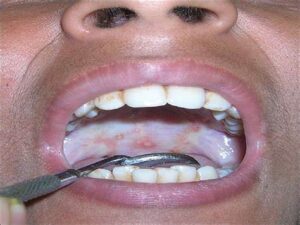What is it?
Oral submucous fibrosis (OSMF) is a chronic, progressive, potentially malignant disorder that affects the oral mucosa, particularly the buccal mucosa (inner lining of the cheeks) and other soft tissues of the mouth. It is characterized by fibrosis (formation of scar tissue) and progressive stiffness of the oral mucosa, resulting in restricted mouth opening (trismus) and difficulty in eating, speaking, and maintaining oral hygiene. OSMF is most commonly associated with the habit of betel nut (areca nut) chewing, particularly in regions where betel quid chewing is prevalent, such as South Asia and Southeast Asia.
Here are some key points about oral submucous fibrosis:
- Etiology: The exact cause of oral submucous fibrosis is not fully understood, but it is believed to result from chronic irritation and inflammation of the oral mucosa, particularly due to the habit of betel nut chewing. Betel nut contains arecoline, a potent vasoconstrictor and fibrogenic agent that can induce fibrosis and collagen deposition in the oral tissues. Other factors implicated in the pathogenesis of OSMF include the use of tobacco, spicy foods, nutritional deficiencies, genetic predisposition, and immunological factors.
- Clinical Presentation: Oral submucous fibrosis typically presents as a progressive, insidious fibrosis of the oral mucosa, initially manifesting as blanching or whitening of the buccal mucosa and soft palate. As the condition progresses, the fibrosis extends to involve other oral tissues, leading to loss of elasticity, reduced mouth opening (trismus), and palpable fibrous bands or ridges along the buccal mucosa and posterior pharyngeal wall. Patients may experience difficulty in mouth opening, altered sensation or numbness in the oral mucosa, burning or tingling sensation, and impaired taste sensation.
- Diagnosis: Diagnosis of oral submucous fibrosis is based on clinical examination, history of betel nut or tobacco use, and characteristic features such as blanching of the oral mucosa, palpable fibrous bands, and reduced mouth opening. In advanced cases, imaging studies such as panoramic radiography or computed tomography (CT) may be performed to assess the extent of fibrosis and rule out complications such as oral cancer. Biopsy may be indicated to confirm the diagnosis and rule out malignancy in suspicious lesions.
- Treatment: Treatment of oral submucous fibrosis aims to alleviate symptoms, prevent disease progression, and improve oral function and quality of life. Management options may include cessation of betel nut and tobacco use, dietary modification (avoidance of spicy or irritant foods), oral hygiene measures, and symptomatic treatment of pain or discomfort. In cases of moderate to severe fibrosis or trismus, interventions such as intralesional corticosteroid injections, physiotherapy, oral splints, or surgical release of fibrous bands may be considered to improve mouth opening and relieve symptoms.
- Complications: Complications of oral submucous fibrosis include increased risk of oral cancer, particularly squamous cell carcinoma, due to the malignant transformation of fibrotic oral mucosa. Patients with OSMF should be closely monitored for signs of malignant transformation, such as ulceration, induration, or non-healing lesions, and referred for further evaluation and management if necessary.
In summary, oral submucous fibrosis is a chronic, potentially malignant disorder characterized by fibrosis and stiffness of the oral mucosa, resulting in restricted mouth opening and difficulty in eating, speaking, and maintaining oral hygiene. The condition is most commonly associated with betel nut chewing and requires early diagnosis and appropriate management to prevent disease progression and complications such as oral cancer. Interventional measures aimed at reducing or eliminating the causative factors and improving oral function are essential for the long-term management of oral submucous fibrosis.

